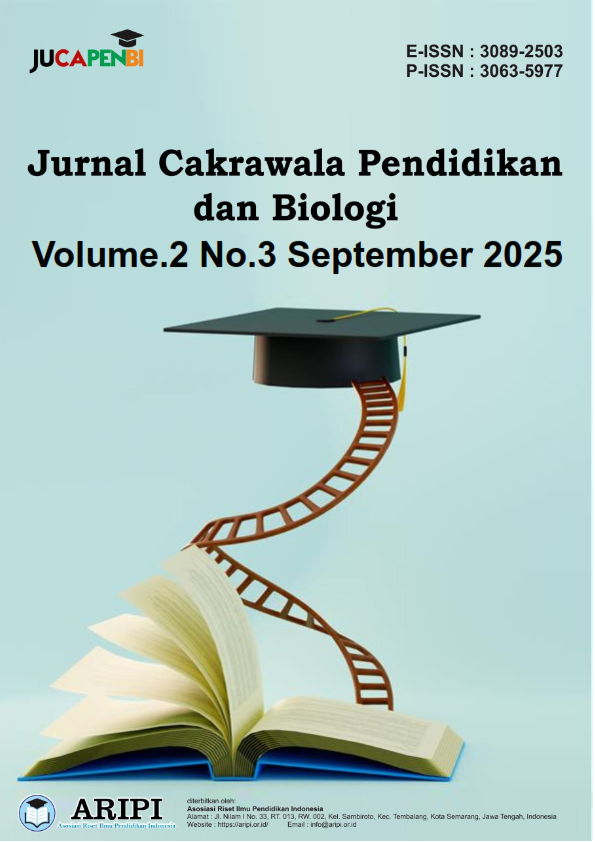Uji Efektivitas Soda Pinus Sebagai Agen Antimikroba Alami Menggunakan Metode Difusi Cakram
DOI:
https://doi.org/10.61132/jucapenbi.v2i3.637Keywords:
Pine soda, Natural antimicrobial agent, Disc diffusion method, Antibacterial activity, Staphylococcus aureusAbstract
Pine soda is a natural fermented liquid from pine needles (Pinus merkusii) which has a distinctive aroma and contains bioactive compounds with potential as antimicrobial agents. This study aims to determine the antibacterial activity of pine soda against Staphylococcus aureus using the disc diffusion method and to compare its effectiveness with the antibiotic ampicillin as a positive control. The process of making pine soda is carried out through simple fermentation of Pinus merkusii pine needles under certain conditions to produce a fragrant liquid. Furthermore, qualitative tests are carried out to identify the content of bioactive compounds, such as flavonoids, phenols, and essential oils, which are known to have antibacterial properties. In the antibacterial activity test, paper discs that have been soaked in pine soda solutions with graded concentrations (2%, 4%, 6%, 8%, and 10%) are placed on agar media that have been inoculated with S. aureus. The results of the observation showed the presence of inhibition zones in each treatment with varying sizes. The largest inhibition zone was obtained at a concentration of 10% with a diameter of 10 mm, which is included in the medium inhibition category. As a comparison, ampicillin produced an inhibition zone of 26.3 mm, while distilled water, the negative control, showed no inhibition zone. These findings indicate that the antibacterial activity of pine soda is influenced by its bioactive compound content, although its effectiveness is still lower than that of standard antibiotics. This potential opens up opportunities for developing pine soda as a safe natural antibacterial agent, whether in the form of health products such as antiseptics, natural cleaners, or functional beverages that support body health. Further research is needed to optimize the fermentation process, increase the concentration of active compounds, and test its effectiveness against various types of pathogenic bacteria.
References
Arif, W. (2018). Uji efek antibakteri minyak atsiri rimpang temu kunci terhadap pertumbuhan bakteri Staphylococcus epidermidis dan Serratia marcescens secara in vitro. Jurnal Pangan dan Agroindustri, 5(3–4).
Cahyanti, L. D., Sumarni, T., & Widaryanto, E. (2015). Potensi alelopat daun pinus (Pinus merkusii) sebagai bioherbisida pra tumbuh pada gulma krokot (Portulaca oleracea). Gontor AGROTECH Science Journal, 1(2), 21–31.
Cahyanti, R., Lestari, S., & Putri, A. (2015). Potensi senyawa bioaktif dari Pinus merkusii sebagai agen antimikroba. Jurnal Bioteknologi Indonesia, 10(2), 85–92.
Hidayati, N., Kurniawan, A., & Setiawan, B. (2018). Aktivitas antimikroba hasil fermentasi bahan alam. Jurnal Sains Farmasi, 14(1), 25–33.
Lateka, J. A., Manurung, T., & Prang, J. D. (2019). Analisis faktor-faktor yang mempengaruhi produksi getah pinus di Kabupaten Poso. D’Cartesian: Jurnal Matematika dan Aplikasi, 8(2), 127–133.
Li, G., Zhao, H., Hong, J., Quan, K., Yuan, Q., & Wang, X. (2017). Antifungal graphene oxide-borneol composite. Colloids and Surfaces B: Biointerfaces. https://doi.org/10.1016/j.colsurfb.2017.06.032
Listari, Y. (2010). Efektifitas penggunaan metode pengujian antibiotik isolat Streptomyces dari rizosfer familia Poaceae terhadap Escherichia coli. Journal Online, 1–6.
Mayefis, D., Marliza, H., & Yufiradani. (2020). Uji aktivitas antibakteri ekstrak daun suruhan (Peperomia pellucida L. Kunth) terhadap Propionibacterium acnes penyebab jerawat. Jurnal Kefarmasian Indonesia, 2(1), 35–41.
Ministry of Health of the Republic of Indonesia. (2016). Indonesian health profile 2015. Ministry of Health of the Republic of Indonesia.
Modul Praktikum Bakteriologi II Program Studi D III Analis Kesehatan Universitas Muhammadiyah Palangkaraya. (n.d.).
Nomer, N., Duniaji, A., & Nocianitri, K. (2019). Kandungan senyawa flavonoid dan antosianin ekstrak kayu secang (Caesalpinia sappan L.) serta aktivitas antibakteri terhadap Vibrio cholerae. Jurnal Ilmu dan Teknologi Pangan, 8(2), 216.
Nurhayati, L. S., Yahdiyani, N., & Hidayatulloh, A. (2020). Perbandingan pengujian aktivitas antibakteri starter yogurt dengan metode difusi sumuran dan metode difusi cakram. Jurnal Teknologi Hasil Peternakan, 1(2), 41–46.
Rahmawati, D., Nugraha, R., & Syafitri, I. (2022). Pengembangan produk herbal berkelanjutan dari tanaman lokal. Jurnal Penelitian Tanaman Obat Indonesia, 28(3), 145–154.
Santoso, H., & Pratiwi, Y. (2021). Eksplorasi tanaman hutan tropis sebagai bahan baku obat herbal. Jurnal Fitofarmaka Indonesia, 8(4), 233–241.
Siregar, B. H., & Nugroho, A. (2020). Potensi ekstrak daun pinus (Pinus merkusii) sebagai bioherbisida terhadap gulma teki (Cyperus rotundus L.). Jurnal Produksi Tanaman, 8(4), 363–369.
Siregar, T., & Nugroho, W. (2020). Resistensi bakteri terhadap antibiotik: Tantangan dan solusi. Jurnal Mikrobiologi Indonesia, 15(2), 59–66.
Downloads
Published
How to Cite
Issue
Section
License
Copyright (c) 2025 Jurnal Cakrawala Pendidikan dan Biologi

This work is licensed under a Creative Commons Attribution-ShareAlike 4.0 International License.






